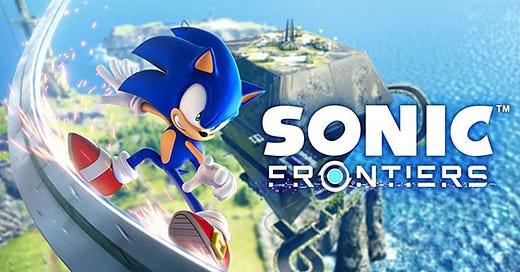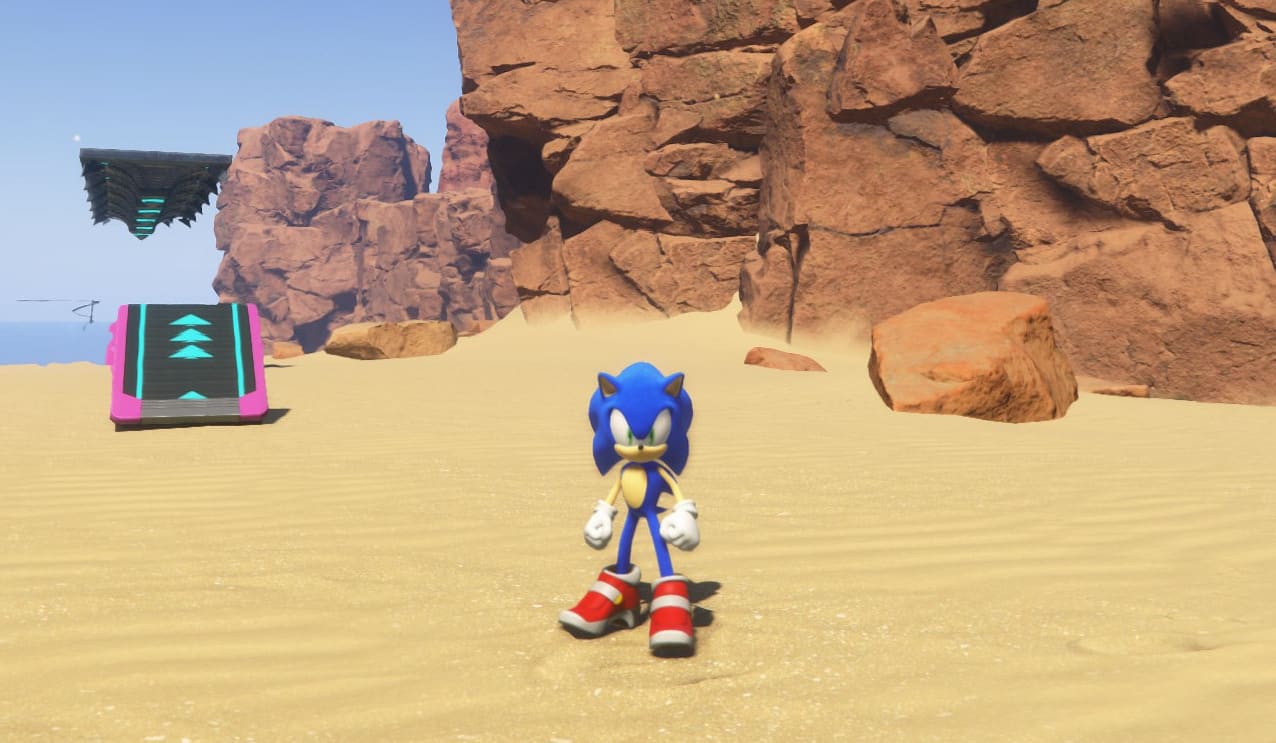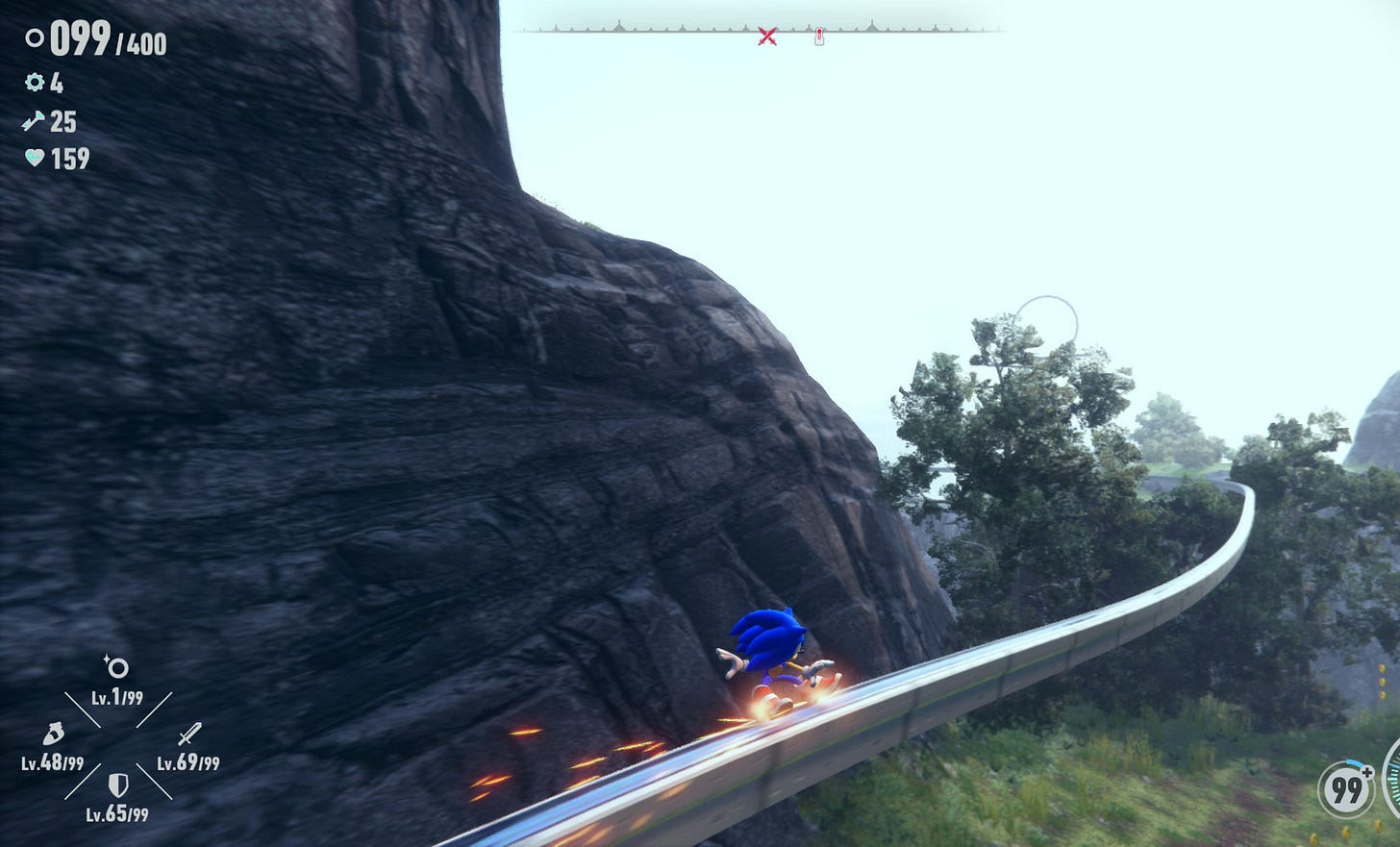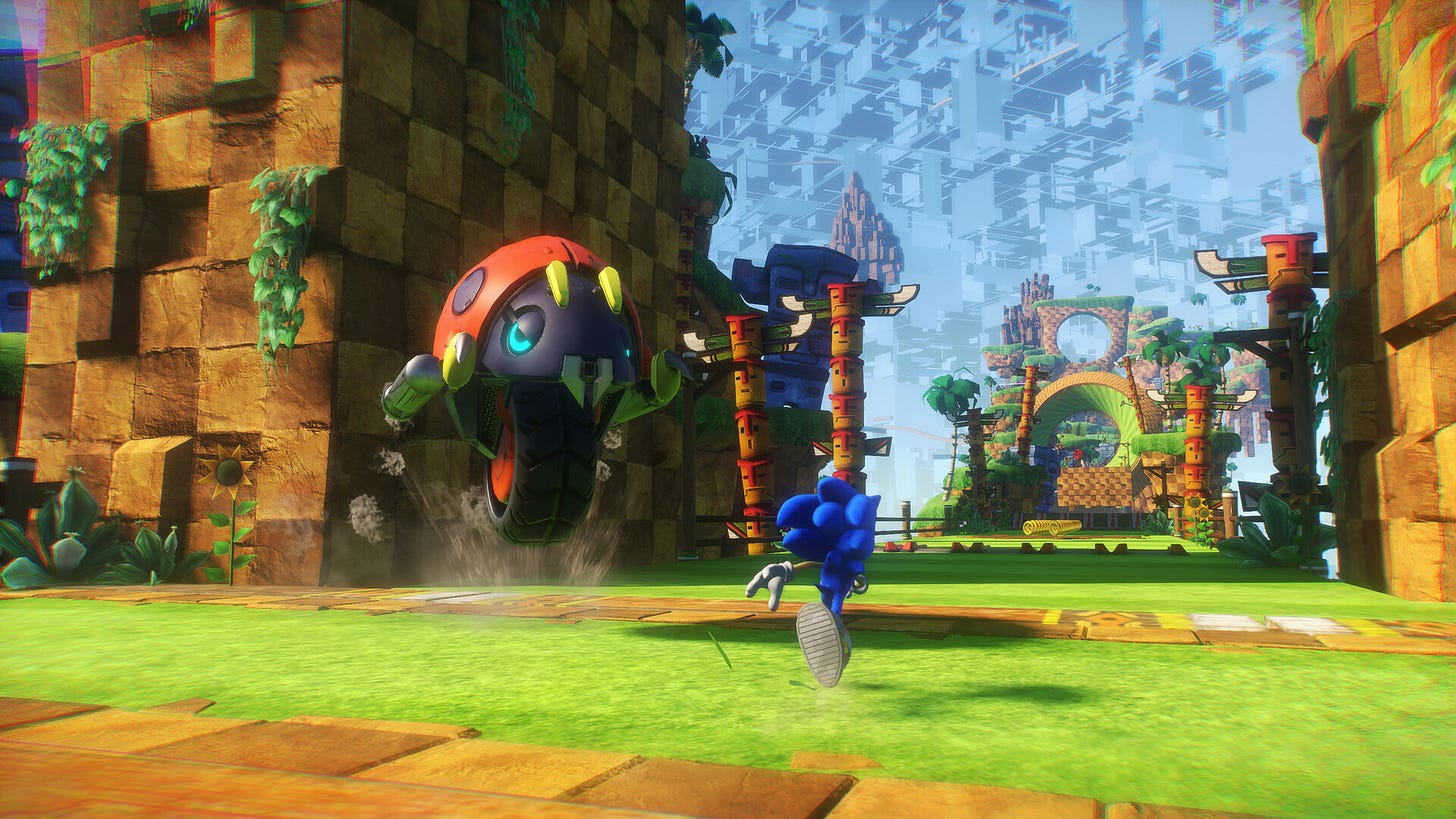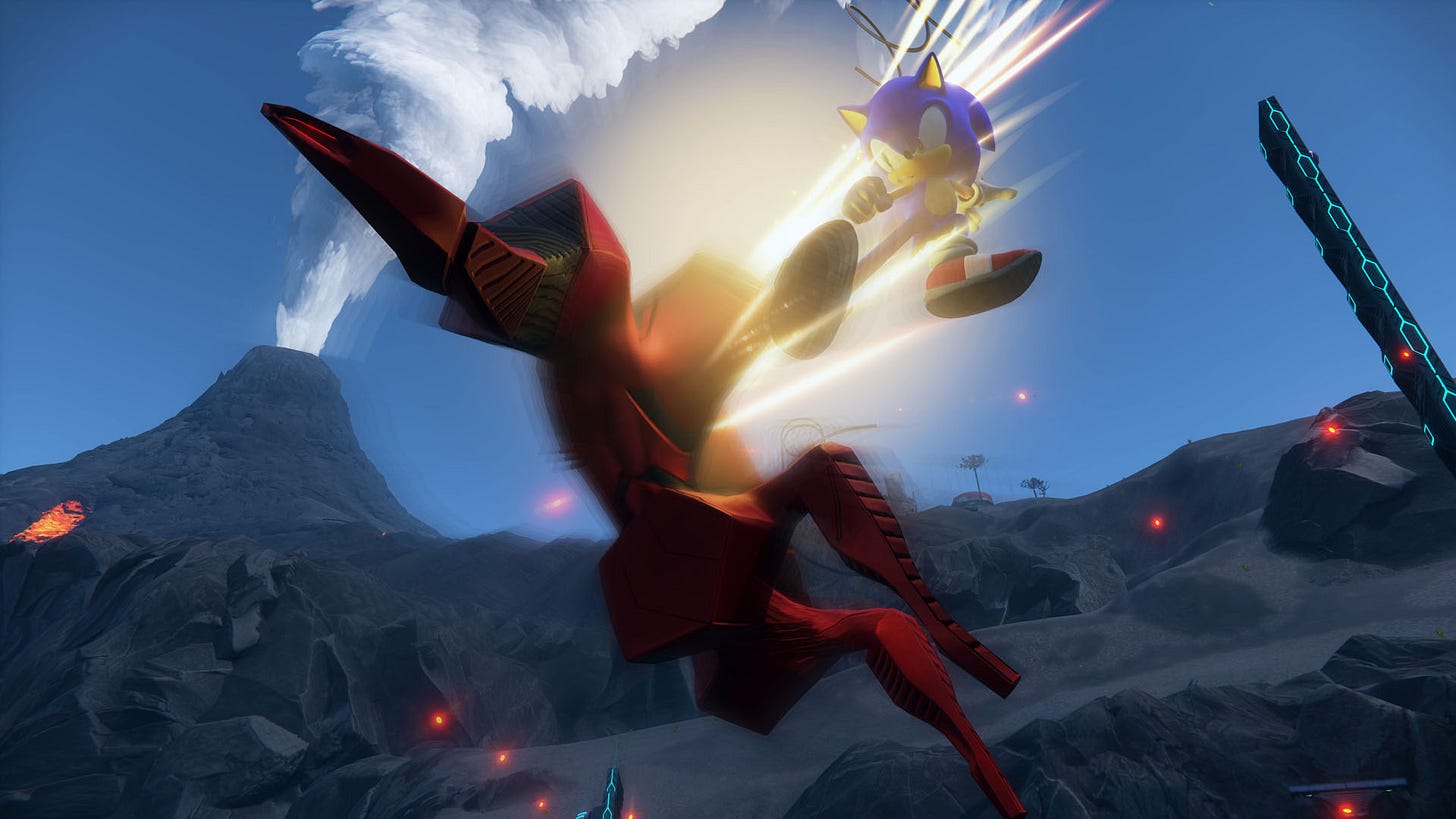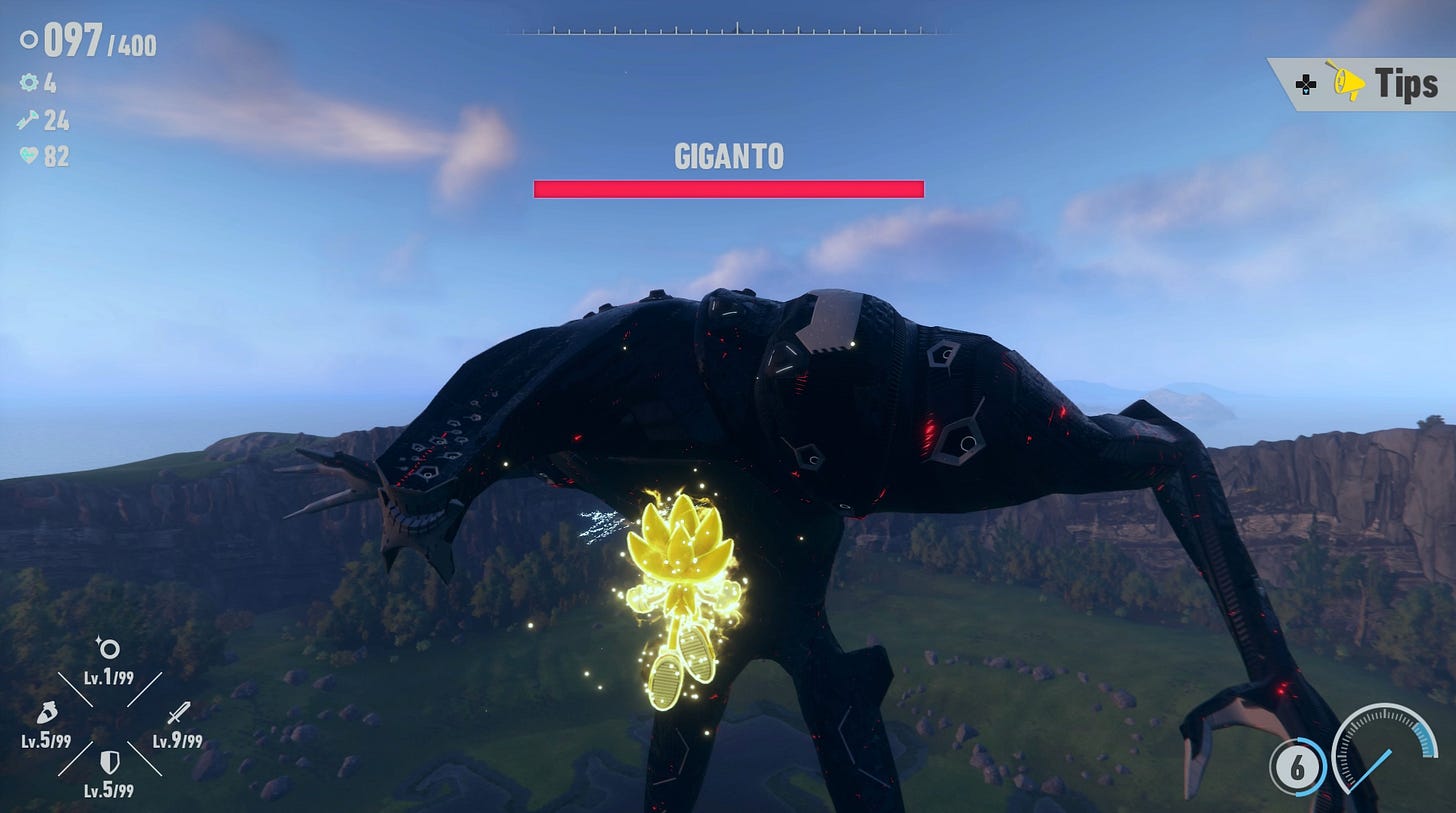I’ve been a Sonic fan for as long as I can remember. In fact, one of the first games I ever played was Sonic Heroes on the PlayStation 2, and it really blew my mind. I’ve kept up with the series, playing almost every 3d game since, with the exception of the Boom series and Lost World. I also went back to play the older games, including the 2d entries. Because of this, I’d say it’s a series I’ve become quite attached to and familiar with. To no surprise, when the reveal trailer for Sonic Frontiers dropped, I was invested. The small video we got initially stoked my interest - it didn’t give much away, yet it still had my attention.
However, as Sega began to demonstrate gameplay, I found myself becoming concerned. I saw Sonic running around a realistic-looking environment and it seemed so jarring. The landscapes seemed like such a clash with the style of Sonic, and I wasn’t hopeful regarding the final product. I also remember hearing the team make repeated mention of the game’s “open zone” design and thinking there was no way it would work. The more I heard about the game, the more I began to sit on the fence about whether I was going to buy it. Upon release, I did consult a few reviews but found my position didn’t change. After all, how could I justify spending £50 on a game I wasn’t sure about?
As luck would have it, Steam had a sale and the game was less than half-price. It was this that actually gave me the push to try the game and, honestly, I’m glad for it. When I played the game, I found it to be really solid.
The clash of styles between Sonic’s obvious cartoon-like appearance versus the realistic environment he was placed in actually worked surprisingly well. I know the series had dabbled with realism before - I’m thinking of the Adventure games and 2006’s Sonic the Hedgehog - but these were still arguably stylised. Sonic Frontiers’ realistic style was, for lack of better phrasing, more realistic. Moreover, I didn’t find the gameplay videos gave a particularly flattering view of the game’s style; it wasn’t until I played the game that I actually started to appreciate its look. Even now, I do find it a bit odd, but it works within the context of the game.
I would have loved to see a more stylised environment - the kind you’d expect in a Sonic game - as I feel the game doesn’t quite pop enough. There are story reasons for why things look the way they do, but I do think a more familiar style would have served the game well. I’m hoping that, if Sega produces a similar game in the future, they will produce an environment with an aesthetic that fits the series more appropriately. Frontiers was well-received, so I’m optimistic that this might encourage Sega and Sonic Team to get more creative with their output. In the future. I think it would be possible for them to produce a game of this scope in a way that feels more faithful to the rest of the series.
Thus far, I have not addressed the game’s plot. I’m not going to touch on the story a great deal in this review because I think it is something best experienced for yourself. Indeed, I didn’t really look into it before I played, and I think that was the right call. It isn’t a particularly long story, but it does feel like they were trying something new with it - something I did appreciate. The narrative does feel like it had more effort put into it than a lot of the newer Sonic games have. It does remind me of the Sonic Adventure games in this regard; their stories feel a lot grander than much of the other titles in the Sonic franchise, and Frontiers felt quite similar in scope. I do particularly like the new character of Sage and how her relationship with Dr Eggman is explored in the game, as we don’t often see a fatherly side to him. It’s a nice way of giving some nuance to the villain. Again, I don’t want to elaborate on the story too much, the point is that it feels well-constructed.
In my opinion, the real draw of this game is the movement. It controls so well, and I find that inputs are extremely responsive. The way this game translates the idea of speed is amazing; you are able to boost around the islands freely, with boosting almost functioning like a sprint in this game. This is the first time in the series where Sonic’s speed has felt good, it’s integrated so naturally into his character, and you do genuinely feel like you’re blasting around at abnormal speed. In previous games, you get restricted access to these bursts of speed, so it feels extremely refreshing to have this ability available at any time. As simple as it is, it is so entertaining to blast around these open spaces; oftentimes I was taken aback by how quickly I could traverse the landscapes.
Sonic games have always had elements of parkour to them, and this entry has really capitalised on that. The “open zones” that had been so concerning to me have actually been crafted with a commendable level of precision; each island is populated by a myriad of parkour elements - such as grind rails, bounce pads and ring trails - that break up the expanses of the islands while also giving you experiences of exhilaration. These elements could have ended up cluttering the environments or feeling repetitive, but they actually manage to remain fresh due to their variety, and you do enjoy picking up collectibles on these sections. It is truly impressive how the ability to gain momentum and speed takes on an addictive quality, to the point where you actually end up running around seeking out these parkour areas.
Pre-release gameplay had convinced me that these would become a chore, but I actually found myself looking forward to completing these sections because I wanted to see where I would end up and how I would do it. I think they were a clever feature of the game that gave the environments character. Most importantly, they were just cool to complete. It is exactly the kind of thing I would associate with Sonic.
During gameplay, you are given the ability to upgrade Sonic’s speed, which is achieved via in-game collectibles. You get the choice between upgrading speed or ring capacity and, to be honest, there seems to be no benefit to upgrading ring capacity; in my entire playthrough I did not increase ring capacity at all, opting to increase my speed each time, and I didn’t feel like I was hindered in any way. Aside from being able to take a few more hits, increasing ring capacity does seem a bit pointless. Considering it is optional - and you can make Sonic faster instead - it doesn’t affect enjoyment of the game, but merely seems like a strange inclusion. The good thing is that the increase in speed was noticeable, meaning you feel like you are getting more powerful as the game progresses, so the ineffectiveness of ring capacity upgrades is just a minor gripe.
Moreover, the islands feature a number of timed challenges you can complete. Doing so fills in your map, which is handy for tracking down missing songs etc. These challenges include anything from dealing a set amount of damage, using the dodge mechanic to move between squares, and jumping over ropes. They really pad out the environment, while giving it variety. I have to say, I enjoyed completing these challenges and filling the map.
The game also has something called Cyber Space levels which act as the kind of Sonic levels you’d be used to. These are okay, but I wouldn’t class them as being special. In fact, I think this aspect of the game is its biggest letdown. They are themed around levels from previous Sonic games which is a trick that I feel Sega has pulled too much at this stage. It was a cool idea in Sonic Generations, and it was great to see classic levels receive a new lick of paint. However, Sonic games have done this countless times since Generations’ release, and it seems like Sega are still trying to recreate the ‘magic’ of that game.
As such, the inclusion of these level types in yet another game just feels underwhelming. It is frustrating because the actual structure of these levels flows nicely, but seeing Green Hill Zone for the millionth time just makes me roll my eyes. It would be one thing for Green Hill Zone to appear on one island, but it actually appears on all of them in some capacity. The same is true for Chemical Plant and Sky Sanctuary. Again, the rest of the game feels like it had a lot of creativity put into it, so it is bewildering to me why they fell short here. There aren’t a huge amount of these levels and they don’t take long to complete, so the vast majority of gameplay occurs in the open world. Because of this, the Cyber Space levels didn’t significantly degrade my enjoyment of the game, I just didn’t find myself excited to play them. It’s a shame Sonic Team recycled content, because I think the opportunity was there for them to include some great new levels.
The combat was also a pleasant surprise to me. When I heard that they were adding combat to the game, I remember thinking, “this is going to be another Sonic Boom”. It’s funny because I hadn’t played Boom prior to Frontiers, yet I had always been aware of its reputation, with its combat being infamously poor. At first, it did feel weird being able to throw punches as the blue blur. But, as I started unlocking combos and deploying them in battle, I actually started to enjoy combat a lot.
The way Sonic Team has implemented it into Frontiers feels natural. It's as if Sonic has always been able to fight - yes, he could do so in Sonic the Fighters, but I’m not counting it because it’s a spin-off. Pulling off a chain of combos is a great feeling; I remember feeling insanely powerful when I got the hang of pulling off different move sets, so I felt like the time I had invested had paid off. Adding to this, certain enemies are weak or resistant to certain moves, and it felt rewarding to figure out what each enemy’s weakness was and how I could exploit it. This added a dimension of tactic to these encounters, something that I was not expecting but do welcome. In fact, this arguably stopped fights from feeling repetitive or cumbersome. One final and minor point is that animations used in these combos look great, to the point where you genuinely feel cool pulling these moves off against your foes.
This segues nicely onto the game’s bosses. There are five in total and, for each fight, you take on the form of Super Sonic. While this sounds pretty awesome on paper, I found that it diluted his power. In previous games, acquiring all the Chaos Emeralds felt like a mission and, consequently, the ability to play as Super Sonic felt like a great reward. In Frontiers, the goal of each island is to acquire the Chaos Emeralds and beat the boss with the power of Super Sonic. You don’t have to do anything taxing to acquire Sonic’s more powerful form; you just have to play the Cyber Space levels and gain enough vault keys to unlock Chaos Emeralds. I think this makes Super Sonic appear almost trivial, as seeing so much of him honestly made him feel underwhelming. In previous games, he was either difficult to obtain or saved for an important purpose, whereas here he’s just there.
The boss encounters were still fun to play and did feel quite grand; the issue is that the sight of Super Sonic lost its lustre pretty quickly. The fights do feel quite creative, with each boss having a distinct vibe. However, I did find the difficulty scaling strange, as some later bosses felt easier than previous ones. I don’t want to go into more detail on the bosses, as I feel this is another part of the game best experienced for yourself. What I will say is that I found the final boss to be massively underwhelming. It is a string of quick time events that doesn’t feel rewarding to beat - extremely underwhelming for a series that is known for having epic conclusions.
I also think it’s worth commenting on the game’s music. Sonic games have become known for their music and it’s often used as a metric for releases in the franchise. I’m not an expert in defining music genres, but I’d say that the soundtrack for Sonic Frontiers falls somewhere in the region of rock, metalcore and/or punk. Sleeping With Sirens vocalist Kellin Quinn is a featured artist on a number of tracks within the game and they sound great. This is especially true of the boss themes, as they really hype you up for a fight. Initially, I had been unsure of the music but I do think it fits the game well. There are some songs I really liked; I don’t think they will reach the classic status of other tunes in the series, but I’ll definitely listen to them again.
Additionally, the game has a jukebox feature. This means that you can listen to whichever Sonic songs you want whenever you want, providing you’ve unlocked them. This is done by finding musical notes that are scattered across the islands. I liked collecting songs because it meant I could listen to my favourites at will. I have to say, it felt so natural - and cool - to boost around the islands with Crush 40 blasting. For some reason, you can only go through the songs one way, meaning that you can’t go back to a song if you accidentally skip it. You have to cycle through them again and this is massively inconvenient. I don’t know why they chose to do this considering the left directional button is unmapped. You can’t even fix this issue yourself.
Conclusion
To conclude, I definitely think this game is worth buying. As I said, I got it on sale for about £20 and this seems like a fair price. I don’t think the game is worth the full retail price of £49.99 just purely because it feels lacking in content. Sonic Frontiers could have done with another island or something to bulk the game up - it just feels like it’s too short to warrant such a high price tag. I’d say that, if you’re considering picking it up, you should pay no more than £35 for it. The game was obviously made with a lot of care and passion; it boasts a strong narrative, solid gameplay and excellent soundtrack. The things that let the game down are minor and shouldn’t put you off buying it for a sensible price. As someone who was undecided on the game, I’m pleased to say it didn’t disappoint me. I’d recommend it to both Sonic veterans and newcomers because it is a really solid and fun experience.
The opinions expressed in this review are based on a Steam PC copy of the game.
Thumbnail image source: Sega


